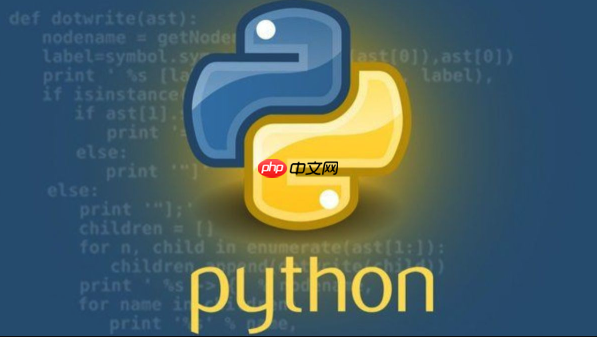Python调用API接口需使用requests库发送HTTP请求,构造URL、方法、头和体,发送后处理响应数据。1.导入requests库;2.构建GET或POST请求,携带参数或数据;3.设置Headers传递认证信息;4.发送请求并检查状态码;5.用response.json()解析JSON数据;6.通过API Key、Basic Auth或OAuth 2.0实现认证;7.处理分页时依limit/offset、page/page_size或next_page_token循环请求直至获取全部数据。

Python调用API接口的核心在于使用各种库发送HTTP请求,并处理返回的数据。常用的库包括
requests
http.client
解决方案
Python调用API接口主要通过以下步骤实现:
-
导入必要的库:
库是首选,因为它简单易用。requests
import requests
-
构造API请求: 确定API的URL、请求方法(GET、POST等)、请求头(Headers)和请求体(Body)。
-
GET请求: 通常用于获取数据,参数附加在URL后面。
url = "https://api.example.com/users?id=123" response = requests.get(url)
-
POST请求: 通常用于提交数据,数据放在请求体中。
url = "https://api.example.com/users" data = {"name": "John Doe", "email": "john.doe@example.com"} response = requests.post(url, json=data) # 使用json参数发送JSON数据 -
Headers: 用于传递额外的请求信息,如认证信息、内容类型等。
headers = {"Authorization": "Bearer YOUR_API_KEY", "Content-Type": "application/json"} response = requests.get(url, headers=headers)
-
发送请求并获取响应: 使用
库的相应方法发送请求,并获取服务器返回的响应对象。requests
-
处理响应: 检查响应状态码,如果状态码表示成功(如200),则解析响应内容。
if response.status_code == 200: data = response.json() # 如果响应是JSON格式 print(data) else: print(f"请求失败,状态码:{response.status_code}") print(response.text) # 打印错误信息 -
错误处理: API调用可能会失败,需要进行适当的错误处理,例如网络错误、服务器错误、认证错误等。可以使用
语句捕获异常。try...except
try: response = requests.get(url, timeout=10) # 设置超时时间 response.raise_for_status() # 抛出HTTPError异常,如果状态码不是200 data = response.json() print(data) except requests.exceptions.RequestException as e: print(f"请求发生错误:{e}")
如何处理API返回的JSON数据?
API通常以JSON格式返回数据。Python的
json
requests
response.json()
例如:
import requests
import json
url = "https://api.example.com/products"
response = requests.get(url)
if response.status_code == 200:
products = response.json()
for product in products:
print(f"Product Name: {product['name']}, Price: {product['price']}")
else:
print(f"Error: {response.status_code}")需要注意的是,API返回的JSON数据的结构可能不同,需要根据实际情况解析。可以使用在线JSON解析器查看JSON数据的结构。
如何使用Python进行API认证?
API认证是确保只有授权用户才能访问API的关键步骤。常见的认证方式包括:
-
API Key: 最简单的认证方式,API Key通常作为请求参数或请求头传递。
url = "https://api.example.com/data?api_key=YOUR_API_KEY" response = requests.get(url) # 或者 headers = {"X-API-Key": "YOUR_API_KEY"} response = requests.get(url, headers=headers) -
Basic Authentication: 使用用户名和密码进行认证,用户名和密码经过Base64编码后放在Authorization请求头中。
from requests.auth import HTTPBasicAuth url = "https://api.example.com/protected_resource" response = requests.get(url, auth=HTTPBasicAuth('username', 'password')) -
OAuth 2.0: 一种更安全的认证方式,使用Access Token来访问API。需要先获取Access Token,然后将其放在Authorization请求头中。
# 获取Access Token (简化示例,实际OAuth 2.0流程更复杂) token_url = "https://example.com/oauth/token" data = {"grant_type": "client_credentials", "client_id": "YOUR_CLIENT_ID", "client_secret": "YOUR_CLIENT_SECRET"} token_response = requests.post(token_url, data=data) access_token = token_response.json()['access_token'] # 使用Access Token访问API headers = {"Authorization": f"Bearer {access_token}"} url = "https://api.example.com/resource" response = requests.get(url, headers=headers)
选择哪种认证方式取决于API提供商的要求。OAuth 2.0通常更安全,但实现起来也更复杂。
如何处理API请求中的分页数据?
很多API会返回大量数据,为了避免一次性返回所有数据导致性能问题,API通常会使用分页机制。分页通常通过以下方式实现:
-
使用
和limit
参数:offset
参数指定每页返回的数据量,limit
参数指定从哪个位置开始返回数据。offset
url = "https://api.example.com/items?limit=10&offset=0" # 第一页 response = requests.get(url) url = "https://api.example.com/items?limit=10&offset=10" # 第二页 response = requests.get(url)
-
使用
和page
参数:page_size
参数指定页码,page
参数指定每页返回的数据量。page_size
url = "https://api.example.com/items?page=1&page_size=10" # 第一页 response = requests.get(url) url = "https://api.example.com/items?page=2&page_size=10" # 第二页 response = requests.get(url)
-
使用
: API会在响应中返回一个next_page_token
,用于获取下一页数据。next_page_token
url = "https://api.example.com/items" response = requests.get(url) data = response.json() next_page_token = data.get('next_page_token') while next_page_token: url = f"https://api.example.com/items?page_token={next_page_token}" response = requests.get(url) data = response.json() # 处理数据 next_page_token = data.get('next_page_token')
处理分页数据通常需要循环发送请求,直到获取所有数据。需要根据API的具体实现方式来确定如何处理分页。
以上就是Python如何调用API接口_PythonAPI请求方法详解的详细内容,更多请关注资源网其它相关文章!




发表评论:
◎欢迎参与讨论,请在这里发表您的看法、交流您的观点。